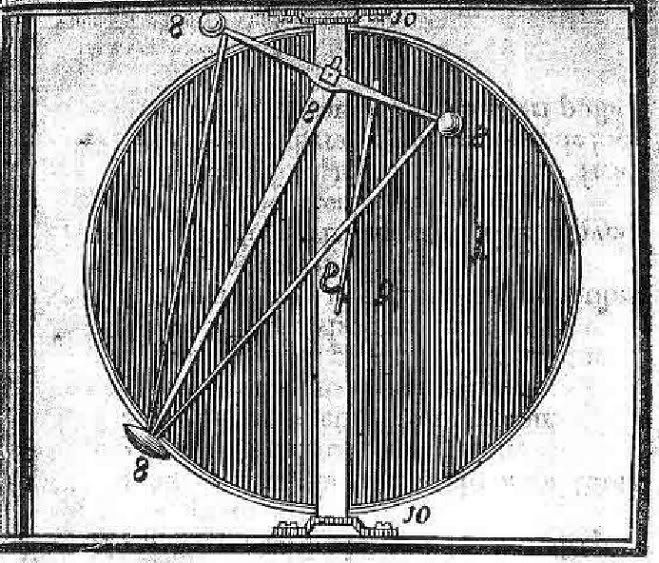cloud camper wrote:Harvey wrote:Ok, you are correct - it does not say "vertical axis" :) Thank you for that keen observation! Since the body of the material is centered inside the wheel, "the axis" must be the wheel axis itself, is that how you read it too?
Yes absolutely! :D This thing basically looks like a clock! (what a surprise from a clockmaker) A clock with four identical hands, the two hands on the left spreading out and closing down in the left hemisphere of the face and the two on the right spreading out and closing down 180 degrees out of phase with the left side. Those hands are heavy but counterbalanced against gravity thru the gearing so it takes no effort to spread them out and close them down with the ropes. But the CoG of the whole device knows the weight is there and where they are laterally with relation to the fulcrum so the teeter totter responds with authority! The pendulums never move at any velocity high enough to create significant centrifugal forces but will generate change in momentum forces so at some rpm the secondary forces will overtake the output energy of the device and the unloaded rpm will stabilize.
In that case, the weights must have some vertical motion which gets translated to axial torque and it evidently happens in sequences, one or the other - perhaps both, but never none (or always one).
Yes absolutely! :D Yes, it's just a teeter totter when the weights on the left side go vertical (one straight up, the other straight down) this completely unloads the left side of the teeter totter. When the weights close down nearly touching each other on the horizontal axis, this loads the left side of the teeter totter to the maximum. At the same time, the right side pendulums are doing exactly the opposite, creating a massive CoG transfer on the teeter totter beam. The main thing to comprehend here is that the weights are not falling, they are just moving the lateral CoG felt by the teeter totter beam. Bessler says "If one weight is given an upward impetus, another one, at the same time is given an equal downward one".
You can think of the vertical CoG of the pendulums as well. When the pendulums spread on the left side, the upper pendulum rises at the same time the lower pendulum descends, so the vertical CoG never changes. Well, just a tiny bit. When the teeter totter rocks up on the left side, the upper weight travels a bit higher than the lower weight descends but when it rocks down, the lower weight descends a bit further than the upper weight, so these offset as well.
There were reports of some sort of sounds like weights dropping or rolling IRCC. So perhaps there may have been some 'Jerk' in there somewhere.
Maybe so but it doesn't fit this proposal too well. This Bessler quote is telling: "He can rack his brains and work his fingers to the bones with all sorts of ingenious ideas about adding extra weights here and there. The only result would be that his wheel will get heavier and heavier - it would run longer if it were empty!"
And this one:"Many would be Mobile-makers think that if they can arrange for some of the weights to be a little more distant from the centre than the others, then the thing will surely revolve. A few years ago, I learned all about this the hard way. And then the truth of the old proverb came home to be that one has to learn through bitter experience"
One more: "The clattering noise you refer to is, I assure you, a phenomenon caused by the real motive power of the machine, and nothing else" Seems safe to say he did not mean falling weights.
I still can't get my brain settled down long enough to ponder your assembly with the ropes and pulleys just yet. You no doubt have it played out in your mind well and I guess I'm too fatigued to get it from the text. But if you forgo the top beam, you lose the mechanism which keeps the planes from tilting. The imaginary line drawn through the adjoined gear axles will not stay parallel to the gravitational force unless they are both mounted to a common pivot embedded in the cross bar and that pivot is connected via linkage to keep the imaginary line vertical.
Yes absolutely :D This has offsetting factors as discussed above so the parallelogram structure is not necessary. I think I figured a simple way to pull the ropes at the correct time. Basically just tied the ropes to various points on the outer wheel with only a couple additional pulleys. The outer wheel was the camshaft and was it's only function except to hide the mechanism. Hope I can duplicate that in WM2D.
But I will try and give this some thought :)
And yes, the WM2D - do I need something to read that file?
Frank, don't let us take away from your thread here - were sort of working together but in different directions perhaps. I want to better understand what your doing too. ;)
Harvey
The Working Model 2D evaluation version is a free download from here:
http://www.design-simulation.com/WM2D/index.php
I hope I can do this in the 2D version. A little worried about stacked components but we'll see.



